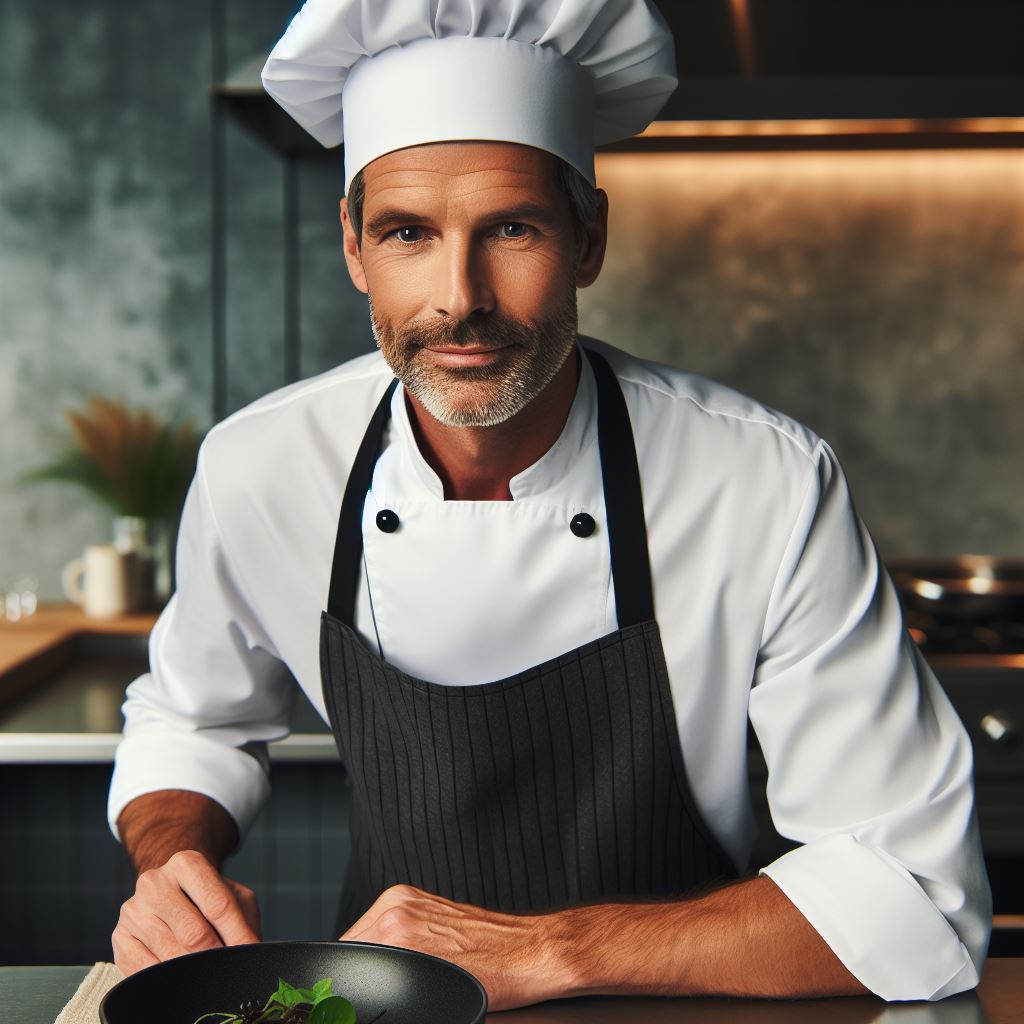Introduction
The culinary industry in Toronto is booming, with an impressive array of restaurants that cater to diverse tastes and preferences.
From trendy food trucks to fine dining establishments, Toronto has it all.
Chefs are at the heart of this vibrant food scene, honing their skills and creativity to deliver unforgettable dining experiences.
A day in the life of a Toronto chef starts early in the morning.
Before the sun rises, they are already in the kitchen, prepping ingredients and planning the day’s menu.
With the city’s bustling food scene, it’s essential for chefs to stay on top of culinary trends and incorporate new flavors and techniques into their dishes.
As the day progresses, the chef’s role evolves into overseeing the entire kitchen operation.
They coordinate with their team, ensuring that every dish meets their high standards and satisfies customers’ expectations.
Despite the fast-paced and often stressful environment, chefs thrive on the excitement and challenge of delivering exceptional meals.
However, being a chef in Toronto is not without its challenges.
Long hours, intense pressure, and the need to constantly innovate are all part of the job.
Yet, these dedicated individuals remain driven by their passion for food and the desire to continuously push the boundaries of culinary excellence.
Preview of what the blog post will cover
In this blog post, we will delve into the daily life of a Toronto chef, exploring their routines and the constant demands they face.
We will also highlight the rewards of their hard work, from receiving accolades to experiencing the satisfaction of seeing happy diners enjoying their culinary creations.
Join us as we step into the world of these talented chefs, who epitomize the vibrant food culture that makes Toronto a culinary destination like no other.
Morning Routine
A day in the life of a Toronto chef begins bright and early.
The alarm clock rings at 5 am, signaling the start of a new day filled with culinary adventures.
The chef knows the importance of starting the day right, so the first thing he does is stretch and take a few deep breaths.
This not only helps to wake him up physically but also mentally prepares him for the challenges ahead.
Once he is up and ready, the chef heads to the kitchen to prepare himself a simple yet nutritious breakfast.
He knows that fueling his body properly is essential for the demands of the day.
A bowl of yogurt with fresh fruits and a cup of coffee is his go-to morning meal.
After breakfast, the chef takes a few minutes to review his schedule and mentally map out the tasks for the day.
He makes a to-do list, prioritizing the most important tasks that need to be accomplished.
This helps him stay organized and focused throughout the day.
Importance of a chef’s mindset and mental preparation
The chef understands that having the right mindset is crucial in his line of work.
He needs to be mentally prepared to handle the pressures of a busy kitchen, especially during peak hours.
He reminds himself to stay calm, composed, and positive no matter what challenges arise.
With his mind in the right place, the chef gathers his tools and sets off for the restaurant.
He arrives around 7 am to make sure everything is in order before the staff starts to arrive.
Arriving at the restaurant or kitchen
Walking into the kitchen, the chef is greeted by the familiar aromas of fresh ingredients and bustling energy.
He takes a moment to appreciate the organized chaos that defines the heart of any restaurant.
The chef quickly dons his chef’s whites and washes his hands thoroughly, ready to start the day.
He inspects the kitchen, ensuring that all the necessary ingredients and equipment are available and in good condition.
He goes through his inventory, taking note of items that need to be restocked. A well-stocked kitchen is essential to meet the demands of customers and deliver exceptional culinary experiences.
Before the staff arrives, the chef uses this quiet time to plan the daily specials and experiment with new recipes.
He believes in constantly evolving and pushing the boundaries of his culinary expertise.
As the rest of the staff trickles in, the kitchen gradually comes to life.
The chef gathers everyone for a quick morning briefing, discussing the day’s specials, any dietary restrictions or allergies to be aware of, and reminding them of the importance of teamwork and communication.
With his morning routine complete, the chef is ready to jump into action.
The kitchen is a dynamic environment, where creativity, precision, and teamwork are key.
The day is just beginning, and the chef is excited to create culinary masterpieces that will wow the taste buds of Toronto’s food enthusiasts.
Preparing for Service
Reviewing the menu and special orders
Before the hustle and bustle of a busy day begins, a Toronto chef starts by reviewing the menu and any special orders.
This allows them to mentally prepare and organize their thoughts for the tasks ahead.
They carefully go through each dish, ensuring they are familiar with the ingredients and techniques required.
Organizing and maintaining the kitchen stations
Next, the chef focuses on organizing and maintaining the various kitchen stations.
This is crucial for ensuring smooth operations during service.
They make sure that each station is clean, well-stocked, and all necessary tools and equipment are readily available.
This helps to avoid any unnecessary delays or confusion during the rush.
Preparing ingredients and ensuring freshness
Freshness is key in any culinary creation. The chef dedicates time to prepare the ingredients, ensuring they are of the highest quality and in their prime state.
They carefully inspect the produce, meat, and seafood, discarding anything that doesn’t meet their standards.
Precise knife skills come into play as they chop, slice, and dice the ingredients with precision and finesse.
In the world of a Toronto chef, attention to detail is everything.
They understand that each component contributes to the overall success of a dish.
From the simplest garnish to the star of the plate, every element deserves proper attention and care.
Once the menu has been reviewed, the kitchen stations organized, and the ingredients prepared, the chef is ready to tackle the challenges that lie ahead.
Their passion ignites as the anticipation builds for the busy service that awaits.
The chef’s journey begins with a steady pace, but as the clock ticks and the orders start pouring in, they find themselves in a symphony of movement.
The controlled chaos of the kitchen comes to life with sauté pans sizzling, oven doors opening and closing, and the sound of knives hitting the cutting boards.
Behind the Scenes: A Glimpse into the Intense and Passionate World of a Toronto Chef
Amidst the commotion, the chef remains focused.
Their years of experience and honed skills allow them to work seamlessly, efficiently, and creatively.
They navigate the kitchen with confidence, orchestrating a harmonious dance between flavors and textures.
Unlock Your Career Potential
Visualize a clear path to success with our tailored Career Consulting service. Personalized insights in just 1-3 days.
Get StartedCollaboration is also an essential aspect of a Toronto chef’s day.
They communicate and coordinate with their sous chefs, line cooks, and other kitchen staff, ensuring everyone is on the same page.
The chef leads by example, guiding and mentoring their team to perform at their best.
As the rush subsides, the chef takes a moment to catch their breath.
They review the orders that have been prepared and ensure every plate meets their high standards.
Attention to presentation is just as crucial as the taste itself.
The chef meticulously arranges each dish, making it visually appealing and appetizing.
In the midst of the controlled chaos, the chef’s love for their craft shines through.
They have dedicated their lives to this profession, constantly learning and evolving.
They thrive on the pressure and challenges that come with being a Toronto chef.
Preparing for service is just a glimpse into the life of a Toronto chef.
This section emphasizes the importance of organization, attention to detail, and teamwork.
It showcases the passion and dedication required to create memorable dining experiences for patrons who walk through the doors of their restaurant.
Read: History & Heritage: Canadian Guide Focus
During Service
Coordinating with other kitchen staff
During service, a Toronto chef must effectively communicate with other kitchen staff to ensure a smooth operation.
The chef coordinates with the sous chef, line cooks, and other team members to ensure everyone knows their responsibilities.
They communicate through verbal instructions, hand signals, and sometimes even written notes to avoid misunderstandings.
The chef ensures that everyone is aware of the menu changes, special requests, and any allergies or dietary restrictions.
They foster a collaborative environment where teamwork and cooperation are essential for a successful service.
Cooking and plating dishes
Once service begins, the Toronto chef heads to the kitchen and starts cooking and plating dishes.
Using various cooking techniques, they transform raw ingredients into delectable dishes.
The chef follows specific recipes and techniques to maintain consistency and ensure that every dish meets the restaurant’s standards.
They pay close attention to cooking times, temperatures, and presentation to guarantee that each plate looks and tastes fantastic.
The chef focuses on balancing flavors, textures, and visual appeal to create a memorable dining experience for guests.
Ensuring food quality and presentation
Throughout service, the Toronto chef is responsible for ensuring the quality and presentation of every dish leaving the kitchen.
They inspect each plate before it leaves the pass, checking for correct seasoning, proper plating, and overall presentation.
The chef pays attention to small details, such as garnishes, sauces, and arrangement, to enhance the visual appeal.
They also taste the dishes regularly to confirm that the flavors are balanced and meet the restaurant’s standards.
The chef takes pride in delivering high-quality food to each customer, aiming to exceed their expectations.
Managing time efficiently
In a fast-paced kitchen environment, time management is crucial for a Toronto chef.
They must prioritize tasks, ensuring that each dish is prepared and served within a reasonable timeframe.
The chef prepares a detailed timeline for each dish and closely monitors its progress to avoid delays.
They coordinate with the front-of-house staff to align the timing of food delivery with the guests’ needs.
The chef must remain calm and organized, even when faced with a high volume of orders during peak hours.
Dealing with last-minute changes or customer requests
During service, a Toronto chef often encounters last-minute changes or customer requests.
They must adapt quickly and efficiently to meet these demands without sacrificing the quality of the dishes.
The chef communicates with the front-of-house staff to address any modifications requested by customers.
They are flexible and creative, adjusting recipes, ingredients, and plating to accommodate special requests.
The chef strives to create memorable dining experiences, going above and beyond to satisfy the customers’ needs.
Basically, during service, a Toronto chef coordinates with other kitchen staff, cooks and plates dishes, ensures food quality and presentation, manages time efficiently, and deals with last-minute changes or customer requests.
This section highlights the essential aspects of a chef’s role during the busy service hours.
Read: Languages: Boosting Your Tour Guide Career
Interacting with Customers
Engaging with diners in an open kitchen concept
- In a bustling Toronto restaurant, the chef interacts directly with customers in the unique open kitchen concept.
- Customers sit at the counter, mesmerized by the chef’s culinary skills and the vibrant atmosphere of the kitchen.
- The chef greets each diner with a warm smile, establishing a personal connection and creating a friendly ambiance.
- As the chef prepares meals, customers eagerly watch, asking questions, and engaging in lively conversations.
- This interactive experience allows customers to witness the artistry and passion that goes into each dish.
Addressing customer concerns and dietary restrictions
- The chef pays close attention to customer concerns and handles them with utmost care and professionalism.
- When a customer expresses dietary restrictions, the chef takes the time to understand their needs and preferences.
- Using their expertise, the chef suggests modifications or substitutes to ensure a delightful and suitable dining experience.
- The chef’s knowledge of ingredients and culinary techniques allows them to accommodate different dietary requirements.
- By addressing customer concerns effectively, the chef ensures every patron feels valued and satisfied.
Providing recommendations and explaining the menu
- The chef serves as a trusted advisor, guiding customers through the menu and suggesting delightful options.
- With a deep understanding of flavors and the culinary composition of each dish, the chef shares their expertise.
- They explain the ingredients, the cooking methods, and the inspiration behind each creation on the menu.
- By offering recommendations, the chef helps customers navigate the extensive selection and discover new flavors.
- The chef’s enthusiasm and passion for their craft enhances the dining experience and leaves customers impressed.
In fact, the role of a Toronto chef extends beyond the kitchen.
They engage customers in an open kitchen concept, addressing concerns, providing recommendations, and explaining the menu.
This level of interaction not only creates a vibrant atmosphere but also ensures customer satisfaction and a memorable dining experience.
Read: Guide to Starting Your Own Tour Company

Maintaining Cleanliness and Safety
As a Toronto chef, maintaining cleanliness and safety in the kitchen is of utmost importance.
It not only ensures the quality and integrity of the food but also prevents foodborne illnesses and ensures the health and well-being of both customers and staff.
Regular cleaning and sanitation practices
Regular cleaning and sanitation practices are fundamental in any professional kitchen.
This involves cleaning and sanitizing all food preparation surfaces and equipment after each use to eliminate any potential pathogens or contaminants.
It is essential to sweep and mop the floors regularly to remove any spills or debris that can cause slips or falls.
Personal hygiene is also crucial in the kitchen.
All chefs and kitchen staff should wear clean uniforms and use appropriate protective gear, such as gloves and hairnets.
Strict personal hygiene practices, including regular handwashing, are crucial to prevent the spread of bacteria and ensure food safety.
Employees should keep their fingernails short and clean to prevent the accumulation of dirt and bacteria.
Adhering to food hygiene standards
Adhering to food hygiene standards is vital to maintain cleanliness and safety.
Proper training on food safety procedures and guidelines should be provided to all employees.
This includes following proper procedures for handwashing, avoiding cross-contamination, and understanding the importance of temperature controls.
Handling and storing food properly
Handling and storing food properly is another essential aspect of maintaining cleanliness and safety.
All food items should be properly labeled and dated to ensure freshness and prevent spoilage.
Raw and cooked foods should be stored separately to avoid cross-contamination.
Using appropriate containers and packaging materials helps protect the food from contamination.
In general, maintaining cleanliness and safety in a Toronto chef’s daily routine is essential for the success of a restaurant.
By following proper cleaning and sanitation practices, adhering to food hygiene standards, and handling and storing food properly, chefs can ensure that their customers enjoy safe and delicious meals.
Read: Cultural Sensitivity in Canadian Tour Guiding
Breaks and Downtime
Taking short breaks to recharge
- In the fast-paced world of being a chef in Toronto, taking short breaks is essential.
- These breaks allow chefs to recharge and refocus their energy for the rest of the day.
- During these breaks, chefs can step away from the kitchen and take a moment to breathe.
- They might grab a quick snack or a cup of coffee to give them a boost of energy.
- Taking breaks also gives chefs a chance to stretch their legs and alleviate any physical strain.
- By giving themselves moments of rest, chefs can avoid burnout and maintain their productivity.
Engaging in team bonding activities
- To foster a positive work environment, Toronto chefs often engage in team bonding activities.
- These activities help build camaraderie and enhance communication among the kitchen staff.
- Chefs may participate in cooking challenges or team-building exercises to strengthen their relationships.
- Team bonding activities also encourage creativity and problem-solving skills among the chefs.
- By working together outside of their usual kitchen tasks, chefs learn to trust and rely on one another.
- These activities not only improve teamwork but also create a more enjoyable and supportive workplace.
Researching new recipes or culinary trends
- During their downtime, Toronto chefs are eager to stay updated on new recipes and culinary trends.
- They spend time researching online, reading cookbooks, and following food blogs for inspiration.
- This research allows chefs to experiment with innovative flavors and techniques in their own creations.
- By staying current with culinary trends, chefs can cater to the ever-changing tastes of their customers.
- Researching new recipes also fosters a sense of curiosity and continuous learning within the culinary industry.
- Chefs understand the importance of staying ahead of the game and constantly challenging themselves.
In short, breaks and downtime are crucial aspects of a Toronto chef’s daily life.
Taking short breaks allows chefs to recharge and maintain their productivity, while team bonding activities create a positive work environment.
Researching new recipes and culinary trends keeps chefs inspired and helps them stay ahead in their field.
All these activities contribute to the success of a Toronto chef and their ability to consistently deliver exceptional culinary experiences.
Post-Service Responsibilities
After a busy day in the kitchen, a Toronto chef’s work is far from over.
The post-service responsibilities are just as important as the prep and cooking process.
Here are some key tasks that need to be completed:
Cleaning up the kitchen and equipment
- Wiping down countertops, stovetops, and any other surfaces used during service.
- Scrubbing pots, pans, and utensils used for cooking.
- Running the dishwasher to ensure all dishes are clean and ready for the next day.
- Taking out the trash and ensuring proper recycling of materials.
- Sweeping and mopping the floors to maintain a clean and safe environment.
Restocking supplies and ingredients
- Checking inventory to assess what needs to be replenished.
- Ordering necessary ingredients and supplies to restock for the next day.
- Organizing the storage areas to ensure everything is easily accessible.
- Rotating stock to maintain freshness and prevent waste.
- Labeling and dating perishable items for proper storage and usage.
Reflection on the day’s service and areas for improvement
After the chaos of service, taking the time to reflect on the day is crucial for a Toronto chef’s growth and continuous improvement.
Some steps they take include:
- Reviewing customer feedback and comments to gauge satisfaction and identify areas for improvement.
- Evaluating the performance of the kitchen staff and offering constructive feedback.
- Assessing the efficiency of processes and workflow during service.
- Identifying any issues or challenges that arose and brainstorming solutions.
- Collaborating with the team to brainstorm new menu ideas or recipes.
This reflection period allows chefs to make adjustments and enhancements to their culinary techniques and the overall service experience.
It is an essential part of their journey towards culinary excellence.
In review, a day in the life of a Toronto chef doesn’t end with the final plate leaving the kitchen.
Cleaning up, restocking, and reflecting on the day’s service are all critical responsibilities that contribute to their success.
It’s a labor-intensive profession that requires attention to detail, dedication, and a constant drive for improvement.
So, the next time you enjoy a delicious meal in Toronto, remember the hard work and commitment that goes into every bite.
Balancing Work and Personal Life
Managing long working hours and stress
- Prioritize tasks and create a schedule to effectively manage long working hours.
- Practice stress management techniques like exercise, meditation, or seeking support from loved ones.
- Set boundaries and learn to say no when necessary to avoid burnout.
- Take regular breaks and vacations to recharge and prevent excessive stress accumulation.
- Communicate with colleagues and supervisors to minimize unnecessary workload and promote a healthy work-life balance.
Finding time for hobbies, family, and self-care
- Allocate specific time slots for activities that bring joy and relaxation, such as hobbies or spending time with loved ones.
- Learn to delegate tasks or seek help when needed, allowing more time for personal activities.
- Set aside time for self-care practices like exercise, reading, or indulging in hobbies that provide relaxation and fulfillment.
- Disconnect from work during personal time by turning off notifications and creating boundaries between professional and personal life.
- Prioritize and make conscious efforts to maintain a healthy work-life balance, understanding the importance of personal fulfillment outside of work.
Pursuing professional development opportunities
- Stay updated with industry trends and advancements through professional development programs or workshops.
- Seek mentorship or networking opportunities to expand professional knowledge and skills.
- Identify areas of improvement and set goals to enhance expertise and remain competitive in the culinary field.
- Attend conferences or seminars to gain insights from industry leaders and expand professional networks.
- Incorporate continuous learning into daily routines, such as reading industry-related articles or experimenting with new cooking techniques.
Balancing work and personal life as a Toronto chef can be challenging, but with proper strategies, it is achievable.
Managing long working hours and stress is crucial to prevent burnout.
By prioritizing tasks, practicing stress-management techniques, and setting boundaries, chefs can maintain their well-being.
Finding time for hobbies, family, and self-care is equally important.
Allocating specific slots for personal activities, delegating tasks when necessary, and disconnecting from work during personal time are effective ways to maintain a healthy work-life balance.
Engaging in activities that bring joy and relaxation helps chefs find fulfillment outside the kitchen.
Additionally, pursuing professional development opportunities is essential to stay competitive in the culinary industry.
By staying updated with industry trends, seeking mentorship, and attending conferences, chefs can enhance their skills and knowledge.
Continuous learning should be incorporated into daily routines to promote professional growth.
In a nutshell, Toronto chefs can find balance between work and personal life by managing long working hours and stress, finding time for hobbies, family, and self-care, and pursuing professional development opportunities.
It requires discipline, prioritization, and effective time management.
Achieving work-life balance ultimately leads to a healthier, more fulfilling career in the culinary field.
Discover More: The Art of Flair Bartending in Canada
Conclusion
A day in the life of a Toronto chef is a whirlwind of activity and passion.
From early mornings at the market to late nights in the kitchen, these chefs pour their heart and soul into creating culinary masterpieces.
Recapping their typical day, we see that it is a constant juggle of planning, prepping, and executing dishes that exceed customers’ expectations.
The pressure is high, but their dedication shines through.
We must appreciate the hard work and sacrifice that chefs put in every day.
Their commitment to their craft deserves our recognition and admiration.
It takes immense skill and talent to make magic happen in the kitchen.
Through this blog section, we hope to encourage readers to explore the culinary scene in Toronto.
There is a vibrant and diverse community of chefs that deserves to be celebrated.
By dining at local restaurants and appreciating the creativity of these chefs, we can support their hard work and contribute to the growth of the culinary industry.
So next time you’re in Toronto, dare to step into new eateries, experience different flavors, and appreciate the artistry of local chefs.
You never know what culinary masterpiece awaits you.




